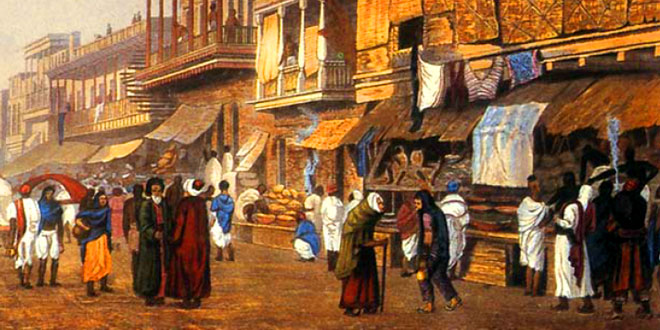Question: Write a short note on the Bauls of Bengal.
Answer: Bengal has a rich tradition of folk music that is sung by the Bauls, dating from the 15th century CE. Bauls are wandering musicians and are an integral part of the culture of rural Bengal. Their songs combine elements of Bhakti and Sufi traditions.
Question: Explain how the Bhakti Movement spurred the development of regional languages.
Answer: Like Sanskrit, Persian never reached the common people. It is in this vacuum that vernacular literature developed with the spread of Bhakti Movement in 12th century CE. The Bhakti saints taught and composed poems in the local languages.
Apart from Hindi (Brajbhasha and Awadhi) and Urdu, other regional language that developed between 8th and 15th centuries CE included Tamil, Bengali, Marathi, Gujarati, Telugu, Kannada and Punjabi.
- Several pieces of secular literature (non-religious) were written by the court poets in Hindi like: Prithviraj Raso by Chand Bardai, Addur Rahim wrote the poets in couplets or dohas.
- Tulsidas one of the Bhakti poet translated Ramayana into Hindi called Ramacharitamanas.
- Surdas, the Bhakti poet from Agra, wrote poems in Brajbhasha in praise of Krishna.
- Meerabai, the great Krishna bhakta, coposed her songs in Hindi.
- The Bhakti saints from Tamil Nadu, wrote songs in praise of Shiva and Vishnu.
- Telugu developed into its present form between 10th and 14th Century CE. Beautiful poetic works were produced like Srivalsa by Srinadha. Several works of literature were written during the rule of the Vijayanagara Kings.
- Krishnadeva Raya, the most famous king of the Vijayanagara Empire, was a scholar of Sanskrit and Telugu. He wrote the poem Amuktamalyada in Telugu. The Mahabharata was translated in Telugu by Tikkanna and Nannayya around 12th century CE.
- Various Sikh gurus taught and wrote in Punjabi, encouraging its growth during medieval period. The Adi Granth, the religious books of Sikhs, was compiled by the fifth guru, Arjan Dev ji, in 1604 CE. Folks songs and stories composed in Punjabi helped the growth of the language.
- Marathi developed as a regional language during the rule of the Bahamani sultans in the Deccan. It was used as their court language. The language grew further as a result of the Bhakti Movement. The Bhakti saints Namdev and Tukaram, wrote devotional poems in Marathi and Sant Jnaneshwar translated the Bhagavad Gita into the language.
- Narsinh Mehta wrote Bhakti songs in the 15th century CE that portrayed his deep love for Krishna.
- One of the best known Gujarati poets is Permanada Bhatta. He wrote wrote poems based on Puranic tales.
- In Bengal, the regional language grew under the influence of Bhakti saints. Chaitanya Mahaprbhu danced to the devotional songs composed in Bengali.
- Krittibas Ojha was a medieval writer who translated Ramayana into Bengali.
- Nair Shah, a king of Gauda in the 14th century CE, is praised by the poet Vidyapati s a patron of vernacular literature.
Question: Describe the nature of medieval paintings found in the Ajanta and Ellora.
Answer: India had a fine tradition in the art of painting. Most of the paintings of the early medieval period were based on religious themes and showed episodes from the Hindu epics, or Jain and Buddhist literature.
The exquisite, beautifully colored paintings at Ajanta and Ellora were created between 600 and 1000 CE. The paintings and sculptures are devoted to Buddhism, Hinduism and Jainism. Most of the paintings tell ancient tales of courtly life, and depict Buddhist stories from the Jataka Tales.
Question: What was the style of paintings introduced by the Mughals? What were its features?
Answer: The rule of Mughals saw the revival of the best in painting, and it marked an important stage in the growth of this art.
- Humayun brought two famous Persian painters with him, Mir Sayyid Ali and Abdus Samad. They introduced the art of miniature painting to India. Miniature paintings are small, but highly detailed, paintings.
- Akbar brought Persian and Indian artists together, and a new style of painting was born-the Indo-Persian School of painting.
- Miniature paintings were also used to illustrate manuscripts and books, examples of which can be seen in the Baburnama, the Akbarnama and the Tutinama.
- Jahangir was deeply interested in painting. Two of the most eminent painters of his time were Abul Hassan and Ustad Mansur.
- Shah Jahan’s reign saw the art of painting reach its zenith. Artists of his time were influenced not only by the Hindu style but the European style as well. Portrait paintings became life-like and graceful during his time unlike the stiff ones of the earlier times.
- Aurangzeb believed in the tenets of the Quran and discouraged painters in his court. They migrated to various regional kingdoms, where they established different schools of paintings.
 Class Notes NCERT Solutions for CBSE Students
Class Notes NCERT Solutions for CBSE Students



Very bad I wanted explanation for this chapter